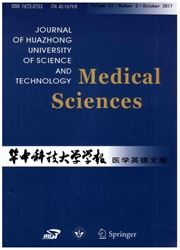

 中文摘要:
中文摘要:
Relationship between ATP changes of rabbit blood and postmortem interval (PMI) was studied. Twenty-four healthy rabbits were sacrificed and randomly divided into 3 groups with 8 rabbits of each group. The bodies of three groups were placed in calorstat at temperature of 15℃, 25℃ and 35℃, respectively. The blood from the right ventricle was sampled through indwelling needle each 4 h until 72 h after death. ATP levels in the blood samples were measured by using ATP fluorescence rapid detection technique at different PMIs. Blood ATP levels slightly increased in the early stage after death and then constantly declined at all temperatures (15℃, 25℃, and 35℃). Cubic polynomial regression equations with log[ATP] as dependent variable (y) and PMI as independent variable (x) at different temperatures and the optimal time period were established as followed: Under 15℃ and during 16-64 h after death, y=-3.027×10-5x3 +0.003x2 -0.096x-10.625 (Ra2 =0.992, P<0.001); under 25℃ and during 8-56 h after death, y=-2.921×10-5x3 +0.002x2 - 0.059x-11.186 (Ra2 =0.989, P<0.001); under 35℃ and during 4-36 h after death, y=-9.769×10-5x3 + 0.005x2 -0.117x-11.166 (Ra2 =0.991, P<0.001). The changes in ATP levels in blood collected from right ventricle of rabbit cadavers showed relatively stable and regular degradation within 72 h after death at different temperatures.
 英文摘要:
英文摘要:
Summary: Relationship between ATP changes of rabbit blood and postmortem interval (PMI) was studied. Twenty-four healthy rabbits were sacrificed and randomly divided into 3 groups with 8 rab- bits of each group. The bodies of three groups were placed in calorstat at temperature of 15℃, 25℃ and 35℃, respectively. The blood from the right ventricle was sampled through indwelling needle each 4 h until 72 h after death. ATP levels in the blood samples were measured by using ATP fluo- rescence rapid detection technique at different PMIs. Blood ATP levels slightly increased in the early stage after death and then constantly declined at all temperatures (15℃, 25℃, and 35℃). Cubic polynomial regression equations with log[ATP] as dependent variable (y) and PMI as independent variable (x) at different temperatures and the optimal time period were established as followed: Under 15℃ and during 16-64 h after death, y=-3.027×10^-5x^3+0.003x^2-0.096x-10.625 (Ra^2=0.992, P〈0.001); under 25℃ and during 8-56 h after death, y=-2.921×10^-5x^3+0.002x^2- 0.059x-11.186 (Ra^2=0.989, P〈0.001); under 35℃ and during 4-36 h after death, y=-9.769×10^-5x^3+ 0.005x^2 -0.117x-11.166 (Ra^2=0.991, P〈0.001). The changes in ATP levels in blood collected from right ven- tricle of rabbit cadavers showed relatively stable and regular degradation within 72 h after death at different temperatures.
 同期刊论文项目
同期刊论文项目
 同项目期刊论文
同项目期刊论文
 Histopathologymappingofbiochemicalchangesinmyocardialinfarctionby Fourier transforminfraredspectrali
Histopathologymappingofbiochemicalchangesinmyocardialinfarctionby Fourier transforminfraredspectrali Preliminary Study on Diffuse Axonal Injury by Fourier Transform Infrared Spectroscopy Spectral Histo
Preliminary Study on Diffuse Axonal Injury by Fourier Transform Infrared Spectroscopy Spectral Histo 期刊信息
期刊信息
